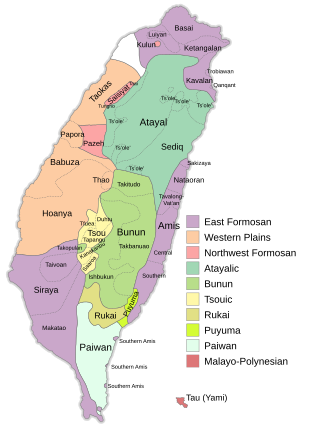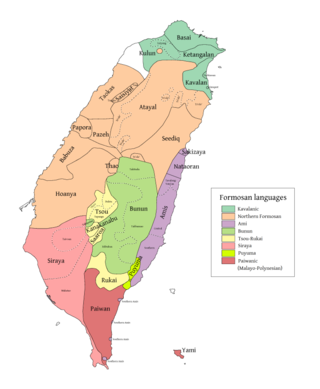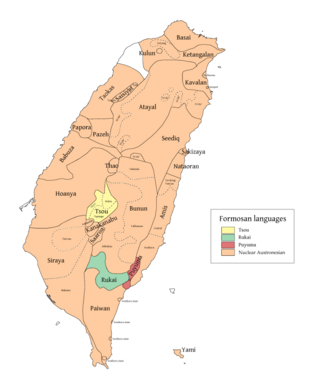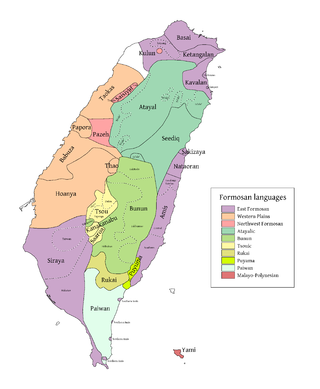
The Austronesian languages are a language family widely spoken throughout Maritime Southeast Asia, parts of Mainland Southeast Asia, Madagascar, the islands of the Pacific Ocean and Taiwan. They are spoken by about 328 million people. This makes it the fifth-largest language family by number of speakers. Major Austronesian languages include Malay, Javanese, Sundanese, Tagalog, Malagasy and Cebuano. According to some estimates, the family contains 1,257 languages, which is the second most of any language family.

The Formosan languages are a geographic grouping comprising the languages of the indigenous peoples of Taiwan, all of which are Austronesian. They do not form a single subfamily of Austronesian but rather up to nine separate primary subfamilies. The Taiwanese indigenous peoples recognized by the government are about 2.3% of the island's population. However, only 35% speak their ancestral language, due to centuries of language shift. Of the approximately 26 languages of the Taiwanese indigenous peoples, at least ten are extinct, another four are moribund, and all others are to some degree endangered. They are national languages of Taiwan.

The Austric languages are a proposed language family that includes the Austronesian languages spoken in Taiwan, Maritime Southeast Asia, the Pacific Islands, and Madagascar, as well as Kra–Dai and Austroasiatic languages spoken in Mainland Southeast Asia and South Asia. A genetic relationship between these language families is seen as plausible by some scholars, but remains unproven.

The Philippine languages or Philippinic are a proposed group by R. David Paul Zorc (1986) and Robert Blust that include all the languages of the Philippines and northern Sulawesi, Indonesia—except Sama–Bajaw and the Molbog language—and form a subfamily of Austronesian languages. Although the Philippines is near the center of Austronesian expansion from Taiwan, there is relatively little linguistic diversity among the approximately 150 Philippine languages, suggesting that earlier diversity has been erased by the spread of the ancestor of the modern Philippine languages.

Basay was a Formosan language spoken around modern-day Taipei in northern Taiwan by the Basay, Qauqaut, and Trobiawan peoples. Trobiawan, Linaw, and Qauqaut were other dialects.

Kavalan was formerly spoken in the Northeast coast area of Taiwan by the Kavalan people (噶瑪蘭). It is an East Formosan language of the Austronesian family.

Tsou is an Austronesian language spoken by the Tsou people of Taiwan. Tsou is a threatened language; however, this status is uncertain. Its speakers are located in the west-central mountains southeast of the Chiayi/Alishan area in Taiwan.

Pazeh and Kaxabu are dialects of an extinct language of the Pazeh and Kaxabu, neighboring Taiwanese indigenous peoples. The language was Formosan, of the Austronesian language family. The last remaining native speaker of the Pazeh dialect died in 2010.
Kanakanavu is a Southern Tsouic language spoken by the Kanakanavu people, an indigenous people of Taiwan. It is a Formosan language of the Austronesian family.
Proto-Austronesian is a proto-language. It is the reconstructed ancestor of the Austronesian languages, one of the world's major language families. Proto-Austronesian is assumed to have begun to diversify c. 4000 BCE – c. 3500 BCE in Taiwan.

Robert A. Blust was an American linguist who worked in several areas, including historical linguistics, lexicography and ethnology. He was Professor of Linguistics at the University of Hawaiʻi at Mānoa. Blust specialized in the Austronesian languages and made major contributions to the field of Austronesian linguistics.

Siraya is a Formosan language spoken until the end of the 19th century by the indigenous Siraya people of Taiwan, derived from Proto-Siraya. Some scholars believe Taivoan and Makatao are two dialects of Siraya, but now more evidence shows that they should be classified as separate languages.

The Tsouic languages are three Formosan languages, Tsou proper and the Southern languages Kanakanavu and Saaroa. The Southern Tsouic languages of Kanakanavu and Saaroa have the smallest phonemic inventories out of all the Formosan languages, with each language having only 13 consonants and 4 vowels. These two languages are highly endangered, as many Southern Tsouic speakers are shifting to Bunun and Mandarin Chinese.

The East Formosan languages consist of various Formosan languages scattered across Taiwan, including Kavalan, Amis, and the extinct Siraya language. This grouping is supported by both Robert Blust and Paul Jen-kuei Li. Li considers the Siraya-speaking area in the southwestern plains of Taiwan to be the most likely homeland of the East Formosan speakers, where they then spread to the eastern coast of Taiwan and gradually migrated to the area of modern-day Taipei.

The Northern Formosan languages is a proposed grouping of Formosan languages that includes the Atayalic languages, the Western Plains languages, and the Northwest Formosan languages.
This article describes the personal pronoun systems of various Austronesian languages.

Luilang, or ambiguously Ketagalan, was a Formosan language spoken south of modern-day Taipei in northern Taiwan by one of several peoples that have been called Ketagalan. The language probably went extinct in the mid-20th century and it is very poorly attested.
Fossilized affixes abound in Austronesian languages.

Sirayaic languages is one of the sub-branches of the Formosan branch, under the Austronesian languages family. Both Blust (1999) and Li (2010) considers Proto-Siraya belongs to East Formosan languages, along with Kavalanic and Amis languages.










